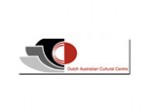Dutch Australian Cultural Centre

The DACC Ltd was founded in 1983 and was registered officially on 30 May 1984 as the Dutch Australian Centre Ltd. In 2002 the name was changed to Dutch Australian Cultural Centre Ltd. It came into being because the need was felt to establish a central organisation to preserve the rich history of Dutch immigration in the country.
Another reason was to become a "resources centre" for persons who wanted to study aspects of the Netherlands, be it economics or costumes and habits. A reference library was therefore established and an archive planned. These functions and activities are progressing now.
The first exhibition organised by the Centre was in the Bondi Pavilion in 1983 of Dutch artists living and working in Australia. Several equally successful exhibitions about immigration followed.
With acceptance grew the confidence in the Centre and the Dutch Government granted the DAC in 1986 an amount of 15.000 guilders, while the Netherlands Society in Sydney made $500 available for the Reference Library. Further grants were received from the Australian Government in 1995, ($14.500 to employ an part-time administrative assistant in 1996) and in 1997 from the Netherlands Benevolent Fund for the reference library. In the last year $5000 for the archives, $1600 for a website and oral history came from the Dutch Government and a total of almost $12.000 from various Australian Government Institutions. Thanks to all this the Centre now employs a part time archivist.
The importance of the DACC grows as the various social Dutch societies and clubs slowly disappear from the scene. However, the grandchildren of the original Dutch immigrants are getting more and more interested in their grandparents' history and want to trace their roots and their lineage. Very few, if any, young members (the children of the immigrants - the second generation) ever joined the existing clubs. They were more interested in assimilating.
There are still a few active clubs left with a broad members base and in a sound financial position. Alas the members are ageing and so are the committees of the clubs. Although this is sad in a way, it makes the position and standing of the DACC Ltd in the Dutch community stronger. The clubs want their history preserved and are collecting their minute books and other documents to hand them over to the archives. Many older Dutch people are doing the same. After all these years the Centre has finally come into its own.
Since 1993 the DACC Ltd has been able to use a building in the grounds of a retirement facility, the Abel Tasman Village in Chester Hill. This was made possible through the support for the Centre from the late Anton Kool, who for many years was the Chairman of the Federation of Netherlands Societies. However, with the ageing of the Dutch immigrants comes a greater need for care and consequently for more space. The DACC moved to 85 Market Street, Smithfield, behind the Dutch shop, in Holland House.
The Dutch Australian Cultural Centre Reference Library and Archives exist to disseminate knowledge and history of Dutch culture and promote the study thereof in Australia by collecting any material relevant to the Dutch-Australian link, for the wider Australian community, in particular those of Dutch descent.
Over the years the collection of books has grown considerably, and of course continue to grow. Many Dutch people donate books along with documents and photos. There is an extensive segment of books about WWII, both in English and Dutch, the former Dutch East Indies and of course Dutch history. A small number of novels are also kept as a snapshot of the taste of the immediate postwar immigrants.
The Library is accessible on request and every possible assistance will be given. As it is a Reference Library, books can be accessed, but cannot be borrowed.
